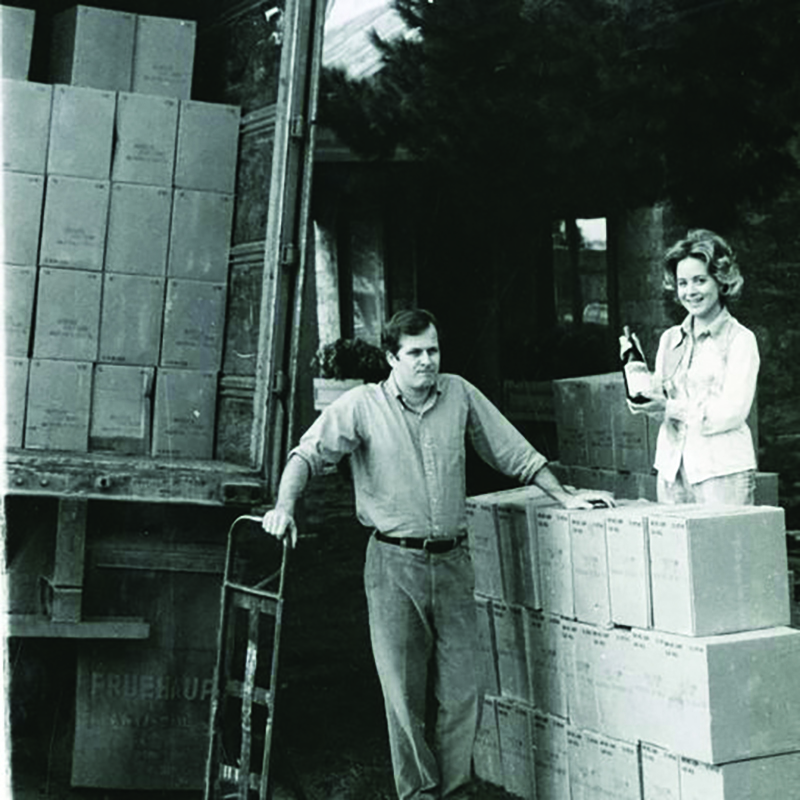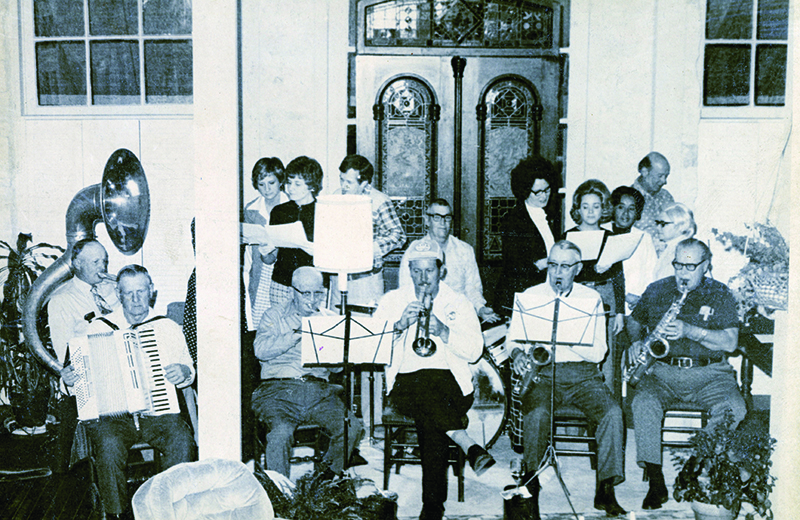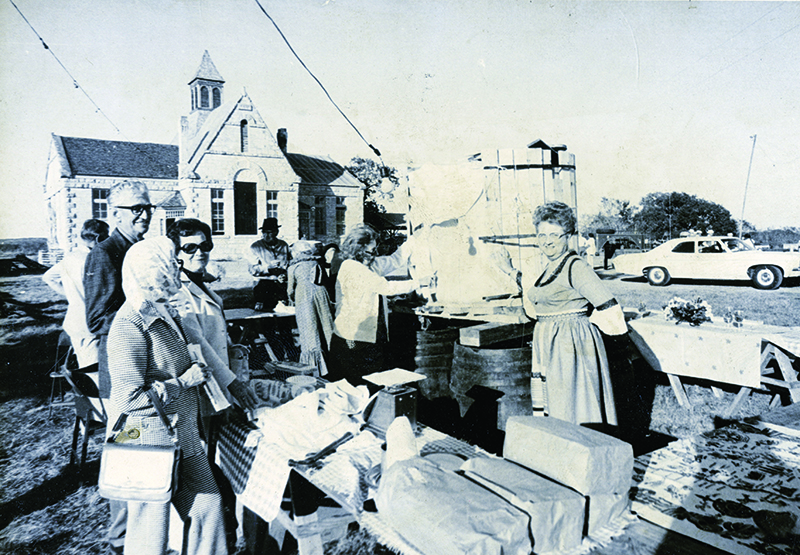German named Halbedhl, while wandering across Texas, spotted a grapevine struggling to grow in poor, rocky soil. Franciscan Friars planted the vine in the 18th century. The friars came to Texas carrying rootstock of Criolla (Spanish) grapes in their haversacks. Impressed with the plant’s will to survive, Halbedhl took a cutting from that sacred vine and replanted it on a picturesque hillside overlooking the Pedernales River near Fredericksburg. As he placed the plant in the ground and carefully shoveled dirt around it with his hands, Halbedhl could hear the blessings of the Friars off in the distance. The Hill Country wine industry began on that hillside, biding its time until it roared to life in the late 20th century.

Great story, but none of it is true. Halbedhl is a myth, and his adventure is a convenient fairytale made up to sell wine. Once upon a time the Hill Country wine industry existed only in the minds of romantics and visionaries. A handful of zealots worked behind the scenes, doing the necessary experiments and tedious grassroots calculations, but the rest of the world paid little attention.
In 1971, Rae Hennon began quietly experimenting with different grapes at his place on Knopp School Road northeast of Fredericksburg. Year after year, Hennon grew a variety of grapes and painstakingly recorded the characteristics of each strain as to size, color, taste, weight, hardiness to cold temperatures and disease resistance. Today Rae Hennon is all but forgotten, but his fingerprints are all over the Hill County wine industry. Retired Gillespie County Extension Agent Duery Menzies called Hennon “one of the unsung heroes of the Gillespie County wine business.”
The Hill Country could claim at least two other experimental vineyards in the early 1970s: one at the Dr. E.A. Blackburn place near the Pecan Creek Community northwest of Fredericksburg and the other at the Rodman Saville place near Tivydale. At the time only one registered winery existed in all of Texas — the Val Verde Winery in Del Rio. (The Qualia family’s facility started in 1882 and survived making church wine). Prohibition killed the rest. A couple of farms near Hondo produced grapes for experimental purposes, and some Texas Tech University professors had experimented with grapes and wine on the South Plains near Lubbock since 1968. With those exceptions the Texas wine industry barely existed.
Real Texans drank beer — on tap, in the can or in the longneck bottle. Sissies drank wine, it was thought. Ask a typical Texan in 1970 to suggest a red and a white wine, chances are he would recommend Ripple (red) and Thunderbird (white), available at 7-Eleven Stores for 89 cents a bottle. Established drinking habits, however, had started to change, even in Texas. With health and weight conscious Americans beginning to turn away from regular beer (light beer sales took off in the mid-70s), and wine consumption predicted to double in the 1980s, people with deep pockets were betting significant amounts of money that Texas grapes and Texas wine were about to become big business. If those predictions held true, an entrepreneur who jumped in early could make a fortune. The wildcat atmosphere of the time attracted legitimate businessmen, mavericks, adventurers and some smooth operators looking to make a fast buck.

In the spring of 1974, when the Hill Country wine rumors had not yet risen above a whisper, a 31-year-old marketing whiz, songwriter and fledgling wine maker named Dean Joyner attracted statewide attention when he and his wife Barbara leased the old Morris Ranch School property from Fredericksburg Independent School District. In an ambitious project allegedly backed by the largest grape co-op in California, Joyner, with great fanfare and a ton of publicity, announced plans to plant a vineyard on the side of a rocky hill, near the Morris Ranch Schoolhouse, not far from the Pedernales River. He named his business Haversack Winery.
Joyner described his marketing strategy as “the back door approach.” He would first market California wine in Texas, build up a cash flow and then “work back” to cultivating Texas grapes for a Texas wine. The label on each Haversack bottle read “from historic Fredericksburg, Texas,” but the wine was pure California, born, bred and bottled. (To be honest it did spend a few days in a Fredericksburg warehouse.) Joyner also claimed that the wine in each bottle contained 5 percent “mission” wine, made from Criolla grapes, brought to Texas and California in the 18th century by Friars in their haversacks.

Dean Joyner told a good story, he had connections, and he knew how to make a splash. The elaborate ceremony that coincided with the planting of the first grapevines at Haversack Winery could have been scripted by a Hollywood screenwriter. A curious crowd gathered at 4 p.m. on March 1, 1975 at the Morris Ranch School. Guich Koock, film and TV actor and one of the owners of Luckenbach, served as master of ceremonies. A vocal group called Die Fröhliche Vier (The Happy Four) sang “The Haversack Ballard,” an original composition written by Joyner. Rev. Dean Pratt, pastor of St. Barnabas Episcopal Church in Fredericksburg, read the Bible story describing Jesus’s first miracle — changing water into wine at the wedding at Cana. That marvel was the first but not the last of the Biblical metaphors invoked that day. The crowd then heard the story of the Spanish priests bringing grapevines to Texas in their haversacks — a dubious claim that gave the winery its name. Mrs. Werner Knopp read the story of the haversack legend in German. Dean Joyner read it in English. Dr. Joe B. Franz, well-known author and director of the Texas State Historical Association, spoke about the history of grapes and wine in Texas.
Then, right on cue, the bells at the Morris Ranch Schoolhouse tolled, signaling the arrival of Franciscan Friars from Mission San Jose in San Antonio. The Friars spoke about the importance of Texas vineyards and Texas wine, used in Holy Communion in the early Spanish missions. As the Friars conducted the centuries’ old “blessing of the grapes” ceremony, Lady Bird Johnson stepped forward and planted the first grapevine. According to reports, Mrs. Johnson enjoyed an occasional glass of a Haversack wine called Straw Blanc. “She’s been serving this wine out at the ranch,” Joyner told a San Antonio Express reporter. “I’ve shipped wine to Lynda (Rabb), and she’s given it away all over New England. They’re really promoting the wine for me.” Mrs. Johnson’s participation in the opening ceremony gave Haversack Winery some as-yet undeserved credibility. Many major newspapers in Texas carried the story, often as a feature in the Sunday edition.
As for Dean Joyner, just about everyone agreed that he was a likeable guy, and he seemed on the level. He certainly brought a lot of attention to Fredericksburg. Whatever he did made news, even scripting a self-serving fairytale about haversacks, a wandering German, sprouting grapevines and Friars chanting off in the distance. That fall Haversack Winery hosted the very first wine festival in Texas at the Morris Ranch School. Attendees drank Haversack Wine and nibbled on a 2,100-pound chunk of cheddar cheese. Pehl’s Old Time Band from Fredericksburg played German tunes. The Ballet Folklorico España of San Antonio performed Mexican folk dances. Vendors sold Haversack Wine T-shirts. Volunteers demonstrated an old wine press, and youngsters stomped grapes. Adults paid $5 to get in, but the price of admission included a special Haversack glass and the wine to fill it — over and over again. Only when supplies ran low did the party show signs of slowing down. That evening some of the guests who had way too much to drink tried to suck wine from the wine press. Quite a few cars, covered with dew, still lined Morris Ranch Road when the sun came up the next morning.
Headaches and hangovers aside, the original Texas Wine Festival focused a lot of media attention on the Hill Country. The word spread. People all over Texas began to associate Fredericksburg with wine. At first, the clamor and the celebration drowned out the complaints. A lot of people ordered Haversack Wine by mail, but the orders never arrived. When a reporter for the San Antonio Express called the Haversack office in Fredericksburg to investigate, he got a recorded message saying the phone was “no longer in service.” Unable to reach anyone at the office for weeks, The San Antonio Express “Action Line” column on May 10, 1976 reported that Haversack Wine was “out of business.” “Not so,” said Dean Joyner when finally spotted by reporters. He had a simple explanation. His home in Fredericksburg sold, so he moved into quarters at the Morris Ranch Schoolhouse. He had trouble getting a phone connection. (It took 4 months.) And all the mail-order wine would be shipped just as soon as the company solved a few minor logistical problems. The Express printed a retraction.
But Haversack Winery had bigger problems than logistics and phone lines. “The backdoor approach” didn’t generate enough income to cover expenses. The company had run out of money months ago, and now it ran out of credit. It existed for a time on flashy headlines, big talk and loud promises. Then time ran out.
In June 1976, Stein Lumber Company in Fredericksburg sued Joyner for a stack of unpaid bills. In July, a Houston design and graphics company sued Joyner for unpaid invoices. In December 1976, the Fredericksburg ISD School Board began the process of cancelling the lease agreement with Haversack Winery. The company had, as Superintendent Crandall Young explained, “defaulted on its lease payments.” By the spring of 1977 Dean Joyner and Gillespie County had parted ways. Weeds grew on the rocky hillside that once attracted so much attention, hope, comedy and drama. The most ambitious wine project in Texas history had fizzled.
After a time of denial, then shock and finally acceptance, Fredericksburg and Gillespie County chalked up the incident as a learning experience, took a deep breath and moved on. Oh well! At least everybody had some fun. And in a strange way the shenanigans at Haversack Winery, and all the publicity (good and bad) they created, put a spotlight on Gillespie County, and may have helped awaken a sleeping giant. The wine business, after all, is a romantic adventure. It attracts dreamers, poets, pirates and risk-takers.
Whatever Haversack’s role in it, the Gillespie County wine industry began to grow faster than the national debt. In 1976, Bob Oberhelman planted three acres of grapes at his farm near Eckert. His Oberhelman/Bell Mountain Winery, the first in the area, opened in 1983. Oberhelman is also responsible for the Bell Mountain region’s designation as an AVA (American Viticultural Area), the first designated wine area located entirely in the state of Texas. (Today there are 8.)
In 1981, Karl and Judy Koch of Corpus Christi planted an acre of grapes at Pedernales Vineyards south of Fredericksburg on Highway 16. Grape Creek Vineyards, between Fredericksburg and Stonewall, the first of the Highway 290 wineries, opened in 1983. Dr. Richard Becker and his wife Bunny of San Antonio established Becker Vineyards between Luckenbach and Stonewall in 1992.
In 1970, Texas could claim one registered winery. In 2023, there are over 500 wineries in the state. The Hill Country alone has over 50 wineries and counting.


